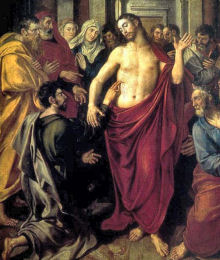Saint Thomas
Saint Thomas
 There is very little about the apostle Thomas in the Gospels; one text calls him the “twin.” Rarely during Jesus’ lifetime does he stand out among his colleagues. There is the instance before the raising of Lazarus, when Jesus was still in Perea and Thomas exclaimed: “Let us also go and die with Him.” Best-known is his expression of unbelief after the Savior’s death, giving rise to the phrase “doubting Thomas.” Nevertheless, the passage describing the incident, had as today’s Gospel, must be numbered among the most touching in Sacred Scripture.
There is very little about the apostle Thomas in the Gospels; one text calls him the “twin.” Rarely during Jesus’ lifetime does he stand out among his colleagues. There is the instance before the raising of Lazarus, when Jesus was still in Perea and Thomas exclaimed: “Let us also go and die with Him.” Best-known is his expression of unbelief after the Savior’s death, giving rise to the phrase “doubting Thomas.” Nevertheless, the passage describing the incident, had as today’s Gospel, must be numbered among the most touching in Sacred Scripture.
In the Breviary lessons Pope St. Gregory the Great makes the following reflections: “Thomas’ unbelief has benefited our faith more than the belief of the other disciples; it is because he attained faith through physical touch that we are confirmed in the faith beyond all doubt. Indeed, the Lord permitted the apostle to doubt after the resurrection; but He did not abandon him in doubt. By his doubt and by his touching the sacred wounds the apostle became a witness to the truth of the resurrection. Thomas touched and cried out: My Lord and my God! And Jesus said to him: Because you have seen Me, Thomas, you have believed. Now if Thomas saw and touched the Savior, why did Jesus say: Because you have seen Me, Thomas, you have believed? Because he saw something other than what he believed. For no mortal man can see divinity. Thomas saw the Man Christ and acknowledged His divinity with the words: My Lord and my God. Faith therefore followed upon seeing.”
Concerning later events in the apostle’s life very meager information exists. The Martyrology has this: “At Calamina (near Madras in India) the martyrdom of the apostle Thomas – he announced the Gospel to the Parthians, and finally came to India. After he had converted numerous tribes to Christianity, he was pierced with lances at the king’s command.”
Excerpted from The Church’s Year of Grace, Pius Parsch
Mass Readings:
July 03, 2020 (Readings on USCCB website)